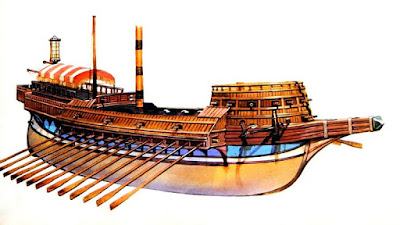This is the third and last installment of the three naval battles which saved the WEST from Eastern or North African domination. The previous two naval engagements, I already posted: SALAMIS in 480 BCE and ACTIUM in 31 BCE.
Gaining supremacy of the Mediterranean basin was of supreme strategic importance for whoever ruled the sea could then invade southern Europe at will, anywhere from Greece to Spain. Occupying Sicily and southern Italy which are at the center of the Mediterranea would be the first tactical objective to be used as the jumping off point for a future invasion of Europe. In the VIII th century, the Arabs did conquer Sicily and Sardinia and kept them for 300 years. Now, 500 years later, was the time of the OTTOMAN Turks.
OTTOMAN EMPIRE
SHOWING LEPANTO
THE NAVAL BATTLE OF
LEPANTO - 1571
The Battle of Lepanto
was a naval
engagement taking place on 7 October 1571 in which a fleet of the
Holy
League, a coalition of European Catholic
maritime
states arranged by Pope
Pius V, financed by Habsburg
Spain and led by admiral John
of Austria, inflicted a major defeat on the fleet of the Ottoman
Empire in the Gulf
of Patras, where the Ottoman forces sailing westwards from their
naval station in Lepanto
(the Venetian name of ancient Naupactus
Ναύπακτος,
Ottoman
İnebahtı)
met the fleet of the Holy League sailing east from Messina,
Sicily.
In the history
of naval
warfare, Lepanto marks the last major engagement in the Western
world to be fought entirely or almost entirely between rowing
vessels, the galleys
and galeasses
which were still the direct descendants of the ancient trireme
warships. The battle was in essence an "infantry battle on
floating platforms". It was the largest
naval battle in Western history since classical antiquity,
involving more than 400 warships.PREAMBULE
The Christian coalition had been promoted by Pope Pius V to rescue the Venetian colony of Famagusta, on the island of Cyprus, which was being besieged by the Turks in early 1571 subsequent to the fall of Nicosia and other Venetian possessions in Cyprus in the course of 1570. On 1 August, the Venetians had surrendered after being reassured that they could leave Cyprus freely. However, the Ottoman commander, Lala Kara Mustafa Pasha, who had lost some 50,000 men in the siege, broke his word, imprisoning the Venetians. On 17 August, Marco Antonio Bragadin was flayed alive and his corpse hung on Mustafa's galley together with the heads of the Venetian commanders, Astorre Baglioni, Alvise Martinengo and Gianantonio Querini.
HISTORICAL BACKGROUND
The Battle of Lepanto took place between the Holy League, consisting of Spain, Venice and the Papacy, and the Ottoman Empire, which lay to the south of Poland and Russia. Two thirds of the Holy League ships were Italian, but Spain contributed most of the financing. The Holy League, under the command of Don Juan of Austria, met the Ottoman fleet, led by Ali Pasha, at Lepanto on 7th October 1571.
THE HOLY LEAGUE
The members of the Holy League were the Republic of Venice, the Spanish Empire (including the Kingdom of Naples, the Kingdoms of Sicily and Sardinia as part of the Spanish possessions), the Papal States, the Republic of Genoa, the Duchies of Savoy, Urbino and Tuscany, the Knights Hospitaller and others.
THE LEAGUE'S COMMANDERS
John of Austria (24 February 1547 – 1 October 1578), in English traditionally known as Don John of Austria, in Spanish as Don Juan de Austria[1] and in German as Ritter Johann von Österreich, was an illegitimate son of Holy Roman Emperor Charles V. He became a military leader in the service of his half-brother, King Philip II of Spain and is best known for his role as the admiral of the Holy Alliance fleet at the Battle of Lepanto
Marcantonio II Colonna (sometimes spelled Marc'Antonio; 1535[1] – August 1, 1584), Duke of Tagliacozzo and Duke and Prince of Paliano, was an Italian aristocrat who served as a Viceroy of Sicily in the service of the Spanish Crown, Spanish general, and Captain General of the Church. He is best remembered for his part as the admiral of the Papal fleet in the Battle of Lepanto.







